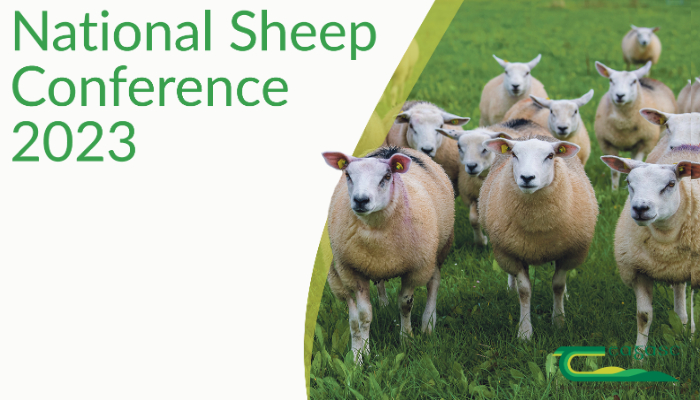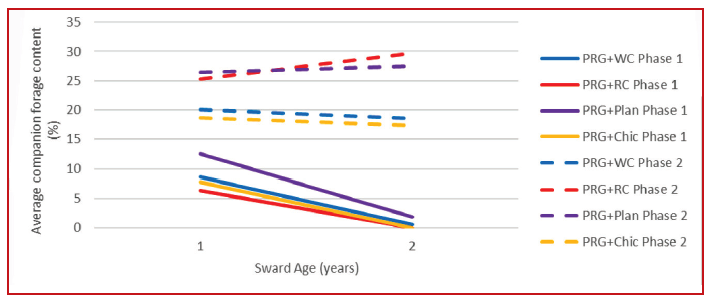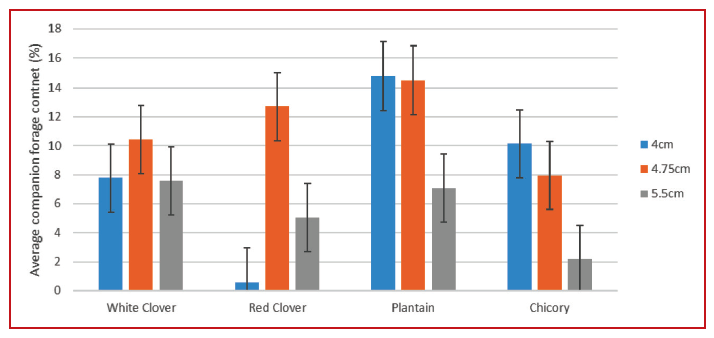30 January 2023
The addition of clovers or herbs to a sheep grazed perennial ryegrass sward: effects on animal and sward performance

Lisa McGrane, Nóirín McHugh, Tommy M. Boland and Philip Creighton presented their research at the recent Teagasc National Sheep Conference.
In recent years there has been growing interest in the use of diverse sward mixtures for grass based ruminant production systems. Numerous studies have shown the benefits of a multispecies sward relative to a perennial ryegrass only sward. These include increased animal and sward performance, reduced requirement for artificial nitrogen application and reduced need for anthelmintic drenches.
A farmlet study was set up in Teagasc, Athenry in 2018, with measurements collected across four production years (2018-2021). The aim of this study was to compare a perennial ryegrass sward to binary sward mixtures of perennial ryegrass and one companion forage, in terms of sward and animal performance under an intensive sheep production system. The sward types under investigation were: i) perennial ryegrass (PRG), ii) perennial ryegrass and white clover (PRG+WC), iii) perennial ryegrass and red clover (PRG+RC), iv) perennial ryegrass and plantain (PRG+Plan), and v) perennial ryegrass and chicory (PRG+Chic). The farmlets were stocked at 11.5 ewes/ha and received 130 kg N/ha/yr.
Animal performance
Lamb performance was measured for four production years (2018-2021) and is shown in Table 1. The addition of any companion forage significantly improved lamb lifetime average daily gain (ADG). Lamb performance was also separated into two production periods: pre-weaning (from birth until weaning) and post-weaning (from weaning until slaughter). Pre-weaning, lamb ADG was similar across the PRG, PRG+WC, PRG+Plan and PRG+Chic sward types. The addition of red clover, led to an increase of 14 g/ day in pre-weaning ADG relative to the PRG sward type. Post-weaning lambs grazing PRG+Chic had the highest ADG of 176 g/day. This was significantly higher than PRG+WC, PRG+RC and PRG+Plan, which were all significantly higher than PRG at 133 g/day.
As a result of improved animal performance, average days to slaughter (DTS) was reduced by 19, 28, 15 and 28 days respectively for lambs grazing PRG+WC, PRG+RC, PRG+Plan and PRG+Chic relative to lambs grazing PRG which took 228 days to reach slaughter weight. Furthermore, reductions in DTS led to reduced rates of concentrate supplementation where average concentrates consumed per lamb drafted was reduced by 6.1, 11.3, 8.2 and 10.7 kg concentrates/ lamb drafted for lambs grazing PRG+WC, PRG+RC, PRG+Plan and PRG+Chic respectively relative to PRG which consumed 14.2 kg concentrates/lamb drafted. Carcass weight, carcass conformation, fat score and kill out percentage were similar across all sward types.
Table 1. The effect of sward type on lamb performance 2018-2021
| PRG | PRG+ WC | PRG+ RC | PRG+ Plan | PRG+ Chic | P-value | |
|---|---|---|---|---|---|---|
| Pre-weaning ADG (g/day) | 237a | 238a | 251b | 236a | 242ab | <0.05 |
| Post-weaning ADG (g/day) | 133a | 155b | 162b | 158b | 176c | <0.001 |
| Lifetime ADG (g/day) | 182a | 204bc | 213c | 199b | 213c | <0.001 |
| Days to Slaughter | 228a | 209bd | 200c | 213b | 200cd | <0.001 |
| kg Concentrates fed/lamb drafted | 14.2a | 8.1b | 2.9e | 6.0c | 3.5d | <0.001 |
Values which share a superscript are not significantly different.
Scanned litter size was similar across all sward types. Ewe milk yield was measured at 5 weeks postlambing in 2018 and 2019 and was not affected by sward type. This result corresponds with the lack of differences recorded in pre-weaning lamb performance, as lambs are dependent on ewes’ milk during this period. Ewe live weight and body condition score (BCS) were measured at five critical time points across the production year. Ewe live weight was similar at mating and scanning, however, differed at 6 weeks post lambing, at weaning and at the following mating. Ewe BCS was similar at all time points except at the following mating. Although some significant differences were observed in ewe performance across the production season, the maximum difference between groups was 6.1 kg, and 0.16 BCS, which would be unlikely to be important commercially.
Herbage production & persistency
All swards were grazed in a rotational grazing system from turnout post-lambing until December in each year. Target pre-grazing sward heights were 7-9 cm (1,200-1,500 kg DM/ha) across all sward types. Target post-grazing sward height was 4.0 cm for the first rotation and 4.5 cm for all subsequent pre-weaning rotations. Post-weaning, a leader-follower rotational grazing system was in place where lambs were removed from the paddocks at a post-grazing sward height of 6 cm, with ewes immediately introduced thereafter to graze to a post-grazing sward height of 4.5 cm.
Herbage production and yield were measured for three production years (2019-2021). Average annual herbage production was 11 t DM/ha, and was similar across all sward types. Annual grazed herbage yield was 9.1 t DM/ha and silage herbage yield was 1.9 t DM/ha, which were also similar across all sward types. For this study all sward types received the same amount of inorganic nitrogen; however, studies have shown that similar levels of herbage production can be achieved from grass and clover swards at lower nitrogen application levels, relative to a perennial ryegrass only sward receiving higher nitrogen application levels. This effect would not be illustrated in the current study but would provide an additional benefit in a commercial setting.
Companion forage content was measured in years 2018-2022. The initial sowings (phase 1) were carried out in 2017 and 2018. Forage contents achieved in this phase were lower than expected and as a result by year 2 average companion forage content was less than 2% for all sward types (Figure 1). This may be down to a number of factors, including the negative impact of the 2018 drought when swards were newly established. Based on the experience of the phase one sowings, sowing management was altered for subsequent reseeding events carried out from 2019 onwards (phase 2) and a series of detailed plot trials (as described below) were established in 2019 and 2020 to investigate some of the possible causes of the poor companion forage establishment and persistence observed in phase 1. The aim of these plot studies was to identify the most suitable management strategies, with an aim towards improving companion forage persistency within a sheep grazing system. There was a higher proportion of the companion forage established in the phase 2 sowings and as a result in year 2 there was 17-30% companion forage content on average in these swards, which is a large increase on those achieved by the phase 1 sowings at the same stage. Although year 3 data is not yet available for phase 2 sowings, results suggest that good levels of the forages will persist into year 3.

Figure 1. Companion forage content from phase 1 and 2 of the farmlet study
Establishment method
A plot study investigating the effect of establishment method on binary sward types was established in July 2019 and measured for the following 2 years. The establishment methods investigated were; i) Conventional (plough, till and sow), ii) Disc (disc harrow followed by power harrow and sow), iii) Power harrow (power harrow cultivation and sow (one pass)), and iv) Direct drill (direct drill with no cultivation of the soil). Results of the study indicate that establishment method had no effect on companion forage content in PRG+WC, PRG+RC and PRG+Chic swards. This is a positive finding as it shows that all establishment methods studied are suitable for use in these sward types and resulted in adequate levels of companion forage content.
Establishment method had a significant impact on plantain content in a PRG+Plan sward. The direct drill method resulted in significantly higher levels of plantain compared to the conventional method. The disc and power harrow establishment methods yielded an intermediate level of plantain content. Unsown species content was also measured in this plot study. Establishment method had a significant effect on unsown species content in the establishment year, however in years two and three of the study unsown species content was similar across all establishment methods.
Post-grazing sward height
Post-grazing sward height (PGSH) has been reported to have a significant impact on the persistency of clovers and herbs in grazing systems. A plot trial was established in July 2019 and measured for the following three years. The PGSHs implemented were; i) 4.0 cm, ii) 4.75 cm, and iii) 5.5 cm. Companion forage contents in the final year of the study are illustrated in Figure 2. Post-grazing sward height had no effect on clover content in a PRG+WC sward. In a year 3 PRG+RC sward there was significantly higher red clover content for the 4.75 cm PGSH relative to both the 4.0 cm and 5.5 cm PGSH. In PRG+Plan and PRG+Chic swards there was significantly lower companion forage content for the 5.5 cm PGSH relative to both the 4.0 cm and 4.75 cm PGSH. These results show that the 4.0 cm PGSH treatment had a negative impact on red clover content as almost none of the red clover persisted into year 3 under this treatment. For the herb sward types (PRG+Plan and PRG+Chic) the 5.5 cm PGSH treatment had a negative impact on herb content.

Figure 2. Companion forage content in a year 3 sward (2022) by post-grazing sward height
Seeding rate
A plot study investigating the effect of seeding rate on binary sward types was established in June 2020 and measured for the following 2 years. A total seeding rate of 25 kg/ha was applied across all plots; within this the companion forage seeding rate was varied to provide a low, medium and high seeding rate as shown in Table 2 below.
Table 2. Seeding rates applied in seeding rate plot trial
|
Low Seeding Rate |
Medium Seeding Rate |
High Seeding Rate |
|
|---|---|---|---|
|
PRG+WC / PRG+RC |
2.5 kg clover/ ha & 22.5 kg PRG/ha |
5.0 kg clover/ ha & 20 kg PRG/ha |
7.5 kg clover/ha & 17.5 kg PRG/ha |
|
PRG+Plan / PRG+Chic |
2.0 kg herb/ha & 23 kg PRG/ha |
3.5 kg herb/ha & 21.5 kg PRG/ha |
5.0 kg herb/ha & 20 kg PRG/ha |
The companion forage contents achieved across the study are shown in Figure 3. Interestingly, in PRG+WC swards white clover content was similar across all three seeding rates. In PRG+RC and PRG+Plan swards companion forage contents significantly increased as the seeding rate increased. In PRG+Chic swards companion forage content significantly increased from a low to a medium seeding rate; however, no additional benefit was achieved by increasing the companion forage seeding rate to the high level for this sward type. For the herb sward types (PRG+Plan and PRG+Chic) the unsown species content was lower for the high seeding rate treatment than for the low seeding rate treatment. This illustrates that the higher herb seeding rate had an ability to out-compete and supress weeds.

Figure 3. Companion forage content by seeding rate
Summary
Binary sward mixtures containing perennial ryegrass and one companion forage are suitable for use in intensive pasture based production systems. Results from this study show that the addition of a companion forage significantly improved lamb performance, particularly in the post-weaning period and reduced days to slaughter by between 16 and 28 days. Overall ewe performance was similar across all sward types, however the leader follower system implemented post-weaning prioritises lamb performance during this period. Annual herbage production was similar for a perennial ryegrass sward and the binary sward mixtures receiving the same nitrogen application rate.
Although not an element of this study, previous research suggests that clover swards may produce the same annual herbage as perennial ryegrass under lower nitrogen application rates. Challenges surrounding companion forage persistency existed; however, improvements in the establishment and persistency of the companion forages were found in the second sowing phase.
Overall establishment method had no effect on companion forage content or weed ingress, with the exception of plantain content, which was higher in a sward sown using the direct drill method than sing the conventional method. Post-grazing sward height significantly affected all sward types with the exception of PRG+WC. The 4.0 cm PGSH had a negative impact on red clover content, whilst the 5.5 cm PGSH had a negative impact on plantain and chicory contents. In the seeding rate trial, the low seeding rate was sufficient for a PRG+WC sward, the medium seeding rate was sufficient for a PRG+Chic sward and the high seeding rate was needed to achieve sufficient levels of companion forage content in PRG+RC and PRG+Plan swards.
Results from these plot trials illustrate that the sward mixtures respond differently to the various management practices. In conclusion, with appropriate management these binary sward types can be successfully incorporated into sheep grazed swards.
Take home messages
- The addition of a companion forage to a perennial ryegrass sward significantly improved lamb performance
- Annual herbage production was similar across all sward types at 11 t DM/ha
- Establishment method had no significant impact on companion forage content with the exception that the direct drill method had higher levels of plantain than other methods
- Seeding rate and post-grazing sward height both affected companion forage content.
